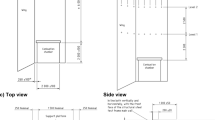Abstract
Fires with a heat release rate that grows quadratically in time and levels off after the first automatic fire sprinkler is activated are routinely used in evaluating the consequences of fire in performance based design projects. In order to calculate the sprinkler activation time one needs to solve the differential equation that governs the heat transfer between the ceiling jet and the sensing element of the automatic fire sprinkler, an equation that depends on the temperature and velocity of the gas. Well-known empirical correlations between ceiling jet properties and heat release rate as well as numerical simulations can be used to determine the temperature and velocity of the gas. Here a comparison and discussion of the results obtained for the activation time and activation heat release rate using both approaches is presented, which can help authorities having jurisdiction to assess safety reports when there are no clear regulations about which method should be applied.










Similar content being viewed by others
Notes
For a viscous fluid the velocity must vanish on the ceiling and hence there must be a maximum at a short distance from the ceiling. To resolve the maximum in a simulation one should take cell sizes smaller than 5 cm, which is beyond the scope of this work.
References
Hadjisophocleous GV, Mehaffey JR (2016) In: Hurley MJ, Gottuk D, Hall JR, Harada K, Kuligowski E, Puchovsky M, Torero J, Watts JM, Wieczorek C (eds) Fire scenarios. Springer, New York, pp 1262–1288. https://doi.org/10.1007/978-1-4939-2565-0_38
Schifiliti RP, Custer RLP, Meacham BJ (2016) In: Hurley MJ, Gottuk D, Hall JR, Harada K, Kuligowsk, E, Puchovsky M, Torero J, Watts JM, Wieczorek C (eds) Design of detection systems. Springer, New York, pp 1314–1377. https://doi.org/10.1007/978-1-4939-2565-0_40
Heskestad G, Bill RG (1988) Quantification of thermal responsiveness of automatic sprinklers including conduction effects. Fire Saf J 14(1):113–125. https://doi.org/10.1016/0379-7112(88)90049-5
Ruffino P, Dimarzo M (2003) The effect of evaporative cooling on the activation time of fire sprinklers. Fire Saf Sci 7:481–492. https://doi.org/10.3801/IAFSS.FSS.7-481
Alpert RL (1972) Calculation of response time of ceiling-mounted fire detectors. Fire Technol 8:181. https://doi.org/10.1007/BF02590543
Alpert RL (2011) The fire-induced ceiling-jet revisited. In: 5th FireSeat symposium
Heskestad G, Delichatsios MA (1979) The initial convective flow in fire. In: Symposium (international) on combustion, vol 17. Elsevier, pp 1113–1123
Heskestad G, Delichatsios MA (1989) Update: the initial convective flow in fire. Fire Saf J 15(6):471–475. https://doi.org/10.1016/0379-7112(89)90017-9
McGrattan K, Hostikka S, Jason F, McDermott R, Vanella M (2022) Fire dynamics simulator user’s guide. NIST special publication 1019
McGrattan K, Hostikka S, Jason F, McDermott R, Vanella M (2022) Fire dynamics simulator technical reference guide volume 3: Validation. NIST special publication 1018-3
Hurley MJ, Munguia A (2009) Analysis of FDS thermal detector response prediction capability. NIST GCR 09-921
Johansson N, Wahlqvist J, Van Hees P (2013) Simple ceiling jet correlation derived from numerical experiments. In: Proceedings of the 13th international interflam conference. Equation 9b and 9c have been revised in this manuscript due to misprint in the original. Interscience Communications Ltd, International Interflam Conference, Interflam. Conference date: 24–26 June 2013, pp 61–72
Alpert RL (2016) In: Hurley MJ, Gottuk D, Hall JR, Harada K, Kuligowski E, Puchovsky M, Torero J, Watts JM, Wieczorek C (eds) Ceiling jet flows. Springer, New York, pp 429–454. https://doi.org/10.1007/978-1-4939-2565-0_14
Heskestad G (1984) Engineering relations for fire plumes. Fire Saf J 7(1):25–32. https://doi.org/10.1016/0379-7112(84)90005-5
Heskestad G (2016) In: Hurley MJ, Gottuk D, Hall JR, Harada K, Kuligowski E, Puchovsky M, Torero J, Watts JM, Wieczorek C (eds) Fire plumes, flame height, and air entrainment. Springer, New York, pp 396–428. https://doi.org/10.1007/978-1-4939-2565-0_13
Beyler CL (1984) A design method for flaming fire detection. Fire Technol 20(4):5–16
Madrzykowski D, Fleming RP (2002) Review of residential sprinkler systems: Research and standards. NISTIR 6941
Khan MM, Tewarson A, Chaos M (2016) In: Hurley MJ, Gottuk D, Hall JR, Harada K, Kuligowski E, Puchovsky M, Torero J, Watts JM, Wieczorek C (eds) Combustion characteristics of materials and generation of fire products. Springer, New York, pp 1143–1232. https://doi.org/10.1007/978-1-4939-2565-0_36
EN 1991-1-2:2002 (2002) Eurocode 1: Actions on structures - Part 1-2: general actions - actions on structures exposed to fire
(2013) C/VM2 verification method: framework for fire safety design. New Zealand
Babrauskas V, Peacock RD (1992) Heat release rate: the single most important variable in fire hazard. Fire Saf J 18:255–272
Author information
Authors and Affiliations
Corresponding author
Ethics declarations
Conflict of interest
The author declares that he has no conflict of interest.
Additional information
Publisher's Note
Springer Nature remains neutral with regard to jurisdictional claims in published maps and institutional affiliations.
Appendix A Models Simulated with FDS
Appendix A Models Simulated with FDS
The geometry simulated with FDS is that of a \(16\times 12\times 6\) m\(^3\) room without lateral walls (open boundaries) and with a flat ceiling. The fire is located on a \(4 \times 4\) m\(^2\) platform raised from the floor between 0.5 m and 3.0 m. That provides a H changing from 3.0 m to 5.5 m. Using the constant HRRPUA method we have simulated a total of 16 models shown in Table 5, for every fuel. Using the constant surface method we have simulated as well a total of 16 models shown in Table 6, for every fuel. Finally Table 7 shows the combustion reaction properties.
Rights and permissions
Springer Nature or its licensor (e.g. a society or other partner) holds exclusive rights to this article under a publishing agreement with the author(s) or other rightsholder(s); author self-archiving of the accepted manuscript version of this article is solely governed by the terms of such publishing agreement and applicable law.
About this article
Cite this article
Toldrà, R. Automatic Fire Sprinkler Activation Time with Quadratic Fire Growth. Fire Technol 59, 2645–2666 (2023). https://doi.org/10.1007/s10694-023-01441-4
Received:
Accepted:
Published:
Issue Date:
DOI: https://doi.org/10.1007/s10694-023-01441-4




